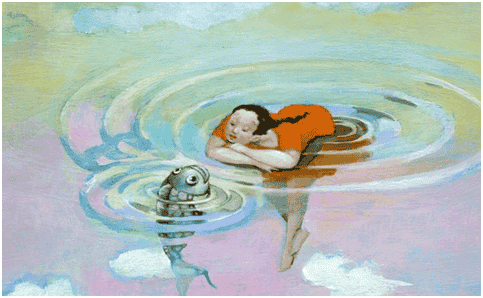
Written and verified by the psychologist GetPersonalGrowth.
Last update: December 14, 2021
A few months ago, the story of a teenager who, after arriving late for school, asked her mother to write her an excuse went viral on the internet. Her mother, probably surprised by the impudence of her daughter, gave a display of originality, justifying the girl's delay with an evil called adolescentism.
The mother, Nicole Poppic, published on her social networks the written justification for her daughter: "This is what happens when you are late because of your senseless choices and you ask me for an excuse".
The justification he wrote to his daughter, Cara, went like this: “Cara was late this morning because of adolescentism. The disease is spreading across the country, but there is still no cure. She presents with different symptoms, but this morning my daughter accused a severe inability to get out of bed, and also a repulsive desire to respond badly to the woman who brought her into the world. She felt much better after I threw the phone out the window for her. Call me if the symptoms come back ”.
"Adolescence is a new birth, as more complete and intense human traits arise in it."
-Stanley Hall-
Adolescentism is the beginning of metamorphosis
Psychologist Stanley Hall, considered a pioneer in the study of adolescence as a developmental stage, described adolescence as a second birth in which a sort of summary of childhood experiences takes place, with the addition of a series of crises and learnings.
Adolescence is a phase that goes from 12 to 20 years and which sees the succession of a series of changes not only physical, but also cognitive, emotional and existential. For this reason, in this phase of one's life one tends to question the world and one's role within it.
The revolution takes place in every respect, since the person finds himself lost in a real emotional and cognitive roller coaster that leads her to behave in a "revolutionary" way.
The rebellion of hormones and the new socio-emotional position justify the "disease" of adolescence in the eyes of all.
One of the most common questions among parents is why, if the adolescent has already developed the ability to think like an adult, he does not act as one. This question has a clear answer: cognitive maturity and emotional maturity do not go hand in hand.
For this reason the adolescent is often emotionally immature in many respects, coming to be almost fluctuating, explosive and temperamental (all characteristics to be traced back to adolescence). However, it is precisely thanks to cognitive or thinking maturity that the adolescent begins the search for his own identity or personal essence.
As a rule, the adolescent has developed emotional abilities that bring him on the same level as an adult. However, unlike the latter, he cannot rely on his entire experience of him therefore it mainly focuses on the analysis of that emotional world of which it tries to absorb the maximum.
It is frequent that during this particular chasm of emotions, the adolescent regularly manifests negative moods and emotions of great intensity, confusing them as they are often simultaneous.
This emotional activation implies such an overload that the adolescent is unable to make full sense of all his emotions, at least not at first glance. In any case, it is good to take into account how this flurry of experiences will help him become aware of the complex set of emotions, thoughts, actions and psychosocial situations that surround him.
Three factors that explain the complex family relationships during adolescence
Millions of parents around the planet will see each other again in the situation we are talking about, or adolescentism. An adolescent son or daughter, in his desire to maintain an exuberant and defiant attitude, will find himself rebelling against the norms imposed by the family or society.
Keep in mind that this is a very confusing phase for the teenager where it is difficult to find oneself, where one changes and reinvents oneself. It is a phase in which instability reigns supreme, making it difficult to see the light at the end of the tunnel.
The complexity of family relationships during adolescence, leaving aside individual differences, can be summarized with the following three factors.
1. Conflicts with parents and with one's position in society
It often happens at this stage that adolescents are treated like children, but they are required to behave like adults, somewhat altering their vision of maturity and the certainties they have of themselves. By doing so, a conflictual stage arises between them and society.
This is a very specific phenomenon called desynchronization. It occurs when the personal development of the individual occurs in an increasingly precocious way, while the integration of the person in the adult and working world occurs late. This prolongs adolescence and often worsens family conflicts.
2. Changes in the mood
The adolescent is, by definition, emotionally unstable. His mood swings are more abrupt than ever and lead him to experience extreme and negative moods more frequently. On average, he experiences a much greater amount of negative feelings during the same day than adults and preteens.
At the same time, he becomes even more unstable, intense and negative if he cannot count on popularity among his peers, if he has a low academic achievement or if he is forced to experience family conflicts such as divorce. Adolescence, always taking into account individual differences, is a phase of life that easily risks becoming "emotionally complicated".
3. Dangerous conduct
Adolescents, driven by the desire to go against what has been established, easily adopt illegal, antisocial, reckless behaviors or, in short, involving a certain risk. Unlike mood swings and family conflicts, these behaviors are more frequent in late adolescence or early youth.
This tendency is explained by impulsiveness and the desire to seek new emotions. These factors, combined with what has been specified above, help us to understand that this is a critical period that requires the supervision and guidance of parents (at the right distance and always taking into account the circumstances).
We must not forget that during adolescence the individual absorbs everything he sees and experiences around him, so it is good to take care of appearances. There is no magic wand that can help us manage this phase, however it is possible to start a phase of preparation for adolescence similar to the one that occurs when a baby is about to arrive in the family.


























